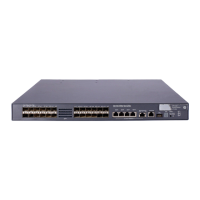49
To do... Use the command... Remarks
Display the global or group-
specific link-aggregation load
sharing criteria
display link-aggregation load-sharing mode
[ interface [ bridge-aggregation interface-
number ] ] [ | { begin | exclude | include }
regular-expression ]
Available in any
view
Display detailed link aggregation
information on link aggregation
member ports
display link-aggregation member-port
[ interface-list ] [ | { begin | exclude | include }
regular-expression ]
Available in any
view
Display the summary of all
aggregation groups
display link-aggregation summary [ | { begin |
exclude | include } regular-expression ]
Available in any
view
Display detailed information
about a specific or all
aggregation groups
display link-aggregation verbose [ bridge-
aggregation [ interface-number ] ] [ | { begin |
exclude | include } regular-expression ]
Available in any
view
Clear LACP statistics for a specific
or all link aggregation member
ports
reset lacp statistics [ interface interface-list ]
Available in user
view
Clear statistics for a specific or all
aggregate interfaces
reset counters interface [ bridge-aggregation
[ interface-number ] ]
Available in user
view
Ethernet link aggregation configuration examples
In an aggregation group, only ports that have the same port attributes and class-two configurations
(see ”Configuration classes”) a
s the reference port (see “Reference port”) can operate as selected ports.
You must ensure that all member ports have the same port attributes and class-two configurations as the
reference port. The other settings only need to be configured on the aggregate interface, not on the
member ports.
Layer 2 static aggregation configuration example
Network requirements
As shown in Figure 14:
• Device A and Device B are connected through their respective Layer 2 Ethernet interfaces
GigabitEthernet 1/0/1 through GigabitEthernet 1/0/3.
• Configure a Layer 2 static link aggregation group on Device A and Device B. Then enable VLAN 10
at one end of the aggregate link to communicate with VLAN 10 at the other end, and VLAN 20 at
one end to communicate with VLAN 20 at the other end.
• Enable traffic to be load-shared across aggregation group member ports based on source and
destination MAC addresses.

